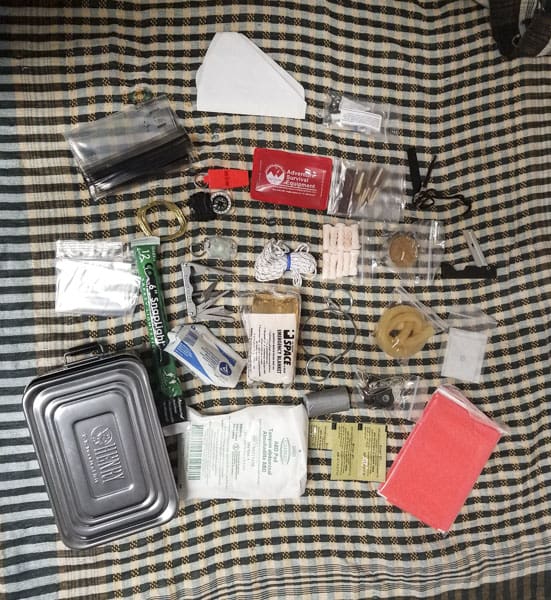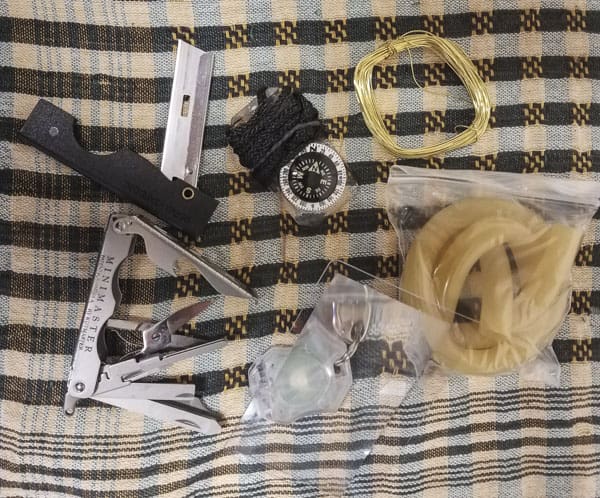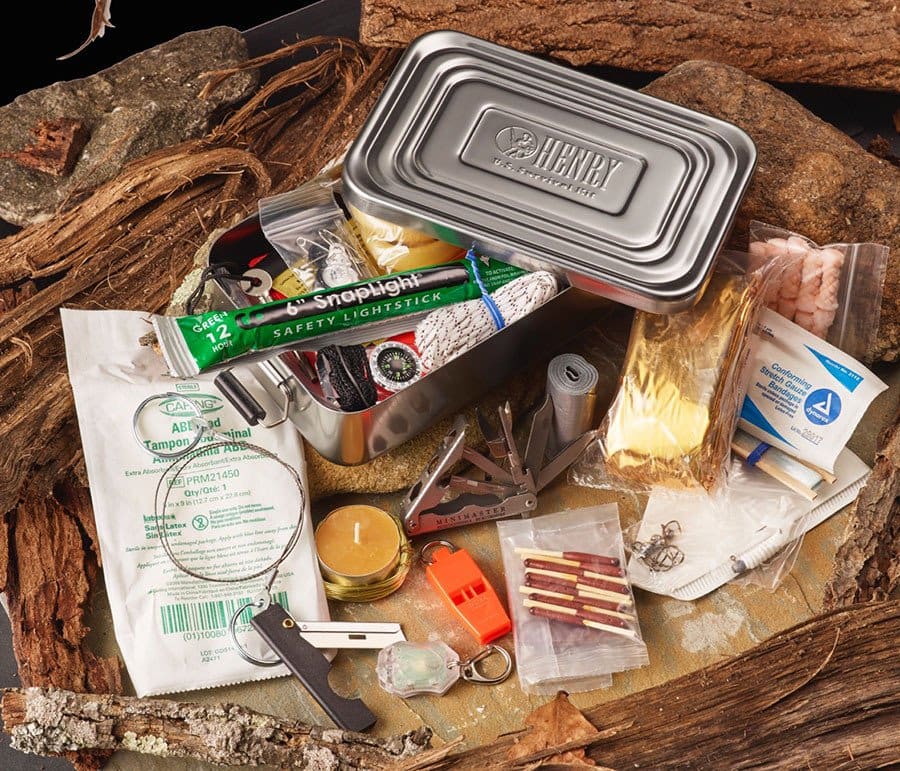
A bonus of reviewing the Henry Survival Rifle was that I got to review the Henry Repeating Survival Kit they sent along with it. I was a teenager in the 80s. Let me tell you, it was pretty awesome. And not just because of the great hair and even better music. No, for anyone who was a kid growing up in a rural area during that time, you probably knew all about the “survival” craze. Today’s prepper” are little more than Johnny-come-lately to those of us who were living in lean-to’s tied with natural cordage when Rambo: First Blood hit the screens in 1982.
I was certainly one of those kids. Even considering how far out in the country I was, I might have taken things to extremes. In my backpack at school I always had a good knife, a small survival kit, and a copy of the SAS Survival Manual.
At an age young enough to get any parent arrested for neglect today, I was spending a week or two alone or with a friend out in the woods, with no one else around for miles. I like to think that “we were fine”, but in fact I still have some sizable scars from those days, and some of my friends have them too. Benefit of all the injuries was that I learned how to sew myself up with nothing but a fishhook and line. By the time my buddy Walter put a hatchet blade through his own knee, I knew how to bandage and splint the wound, make a travois, and drag him out of the woods to get help. Those were all skills that proved extremely valuable later in life.
Those skills are important. With some knowledge and experience, water and weapons, there isn’t much you can’t handle in the wild…if you have time. And you’re healthy. The reality is that you can freeze to death, bleed to death, and starve to death fairly quickly, depending on your circumstances. That’s why a small amount of quality gear can make a huge difference in a life or death situation.
Good gear gives you options. You can handle yourself fine all by yourself when things are going well. When they aren’t, you need to tool up.

For the past several months, the books in my truck included the Henry Survival Kit. I haven’t been disappointed. And commercial survival kits usually disappoint me.
They often contain Band-Aids, some alcohol prep pads, thin twine, and tools that are likely to break under almost any hard use. That’s why I was impressed with Henry’s kit. It wasn’t the number of items included, it was the quality of those items and their usefulness.
First off, the multi tool included isn’t a cheap Chinese knock-off. It’s a small, but versatile tool made in upstate New York, and it’s of the same quality you’ll find throughout the kit. That goes for compass and the Photon Micro Light, too — quality tools that will actually work when you need them.

The kit includes few things that many others don’t. The water-tight bag is something every single kit should have. Not only does Henry include one, but it’s surprisingly sturdy. The same thing goes for the coffee filter. Sure, you should sterilize your water if you have time, but how are you going to get all that dirt and mud out of it in the first place? With a coffee filter. Cheap, easy, and super useful, but left out of most kits.
Also appreciated is the 20 feet of snare wire. In lots of survival situations, hunting is done the hard way and snares are where it is at. Twenty feet is enough to make several snares, which you’re likely to need. On top of that, I’ve had great luck using wire wrapped around a piece of curved wood with a hook on the end as a lure for bass. Just throw it out and pull it back fast and the small mouths just can’t seem to resist it.
The Henry Survival Kit includes an item I have always considered vital, but is conspicuously absent in many other store-bought kits today…surgical tubing. This is one of the most versatile and useful items in your kit. From straws to shelter to slingshots and beyond, you will be glad you have it.
And there’s a lot more. Sure, waterproof matches are waterproof matches, a candle is a candle and a razor blade is a razor blade. But the razor is housed in a folding handle, those waterproof matches come with a striker, and the candle is made of bees wax (instead of paraffin) that you can use as a wound sealant. Just about everything here is the best version of what’s available, and was clearly thought out by someone who’s spent a few nights tired and cold out in the sticks.
Not everything here is perfect, though. The wire saw is one of the few disappointments. It’s the simple spiral wire type, which will in fact cut through lots of different materials — really anything wood or plastic — eventually. But there are much more aggressive saw types out there that will cut much faster and with less effort. No, they don’t last as long, but in an emergency situation where you need to cut down some limbs to build a fire to stave off hypothermia, you don’t need lasting power, you need wood right now.
The other disappointment is that the small trauma dressing should be replaced with a modern hemostatic agent, such as QuickClot Combat Gauze. That would, however, certainly increase the price of the kit and may not be safe for children. And Henry includes the necessities for trauma management…gauze and (basically) duct tape, and enough of it to get most jobs done. No worthless band aids and prep pads in this kit.
The Henry Survival Kit includes several ways to start a fire, and if you’re wet and cold, you might need every one of them. It also includes a 12-hour chemlight, an absolute requirement when your hands don’t work well from the cold or a concussion and your batteries are dead. And the space blanket? Most people have no idea how well one works until they’ve tried it.

One more big difference in quality is the case itself. Secured with easy-on-and-off claps, this case is made of anodized aluminum, not some cloth bag with SureToBreak™ zippers. In fact he case itself is a survival tool, and although “not recommended” for cooking by Henry, it will certainly do in a pinch.
Specifications: Henry Repeating Survival Kit
The Survival Kit contains:
Basic Survival Instruction Sheet
Aloksak Water Tight Bag
Personal Use Fishing Kit
Mini Map Compass
Mini Rescue Flash Signal Mirror
Beeswax Tea Light Survival Candle
Tinder Quick (10)
Type 1A Utility Cord (20 ft)
Photon Micro Light
Sewing Kit
Spiral Wire Survival Saw
1 ft flexible latex tubing
Trauma Bandage and Gauze Roll
Adventurer Compact Repair Tape
Adventurer Compact Fire Starter
Rapid Rescue Survival Whistle
Snare Wire (20 ft)
Adventure All Weather Matches (10)
Utica Kutmaster Mini Multi Tool
Flat Coffee Filter
Water Bag
MicroPur Water Tablets (05)
12 Hour Light Stick
Space Survival Blanket
Compact Signal Panel
Silica Gel
Fresnel Lens Fire Starter
Derma Safe Razor Knife
The Survival Kit Box itself:
Hard Anodized Aluminum
Size: Appx 7.3″ x 4.6″ x 2.3″ (including clasps)
Weight: 6.2 oz
Fire and Water Resistant
Extremely Durable
Not recommended for cooking
Price: $99.95
Ratings (out of five stars):
Overall * * * * 1/2
All in all, a great kit and a very good value. Not surprised, since it’s from Henry.




Cool review! If I didn’t roll my own kits this would be a nice option. $100 isn’t cheap, but it’d be worth it for decent component parts.
I never thought of the coffee filter trick. I’m not a coffee drinker. But you can bet I’ll buy filters next store trip.
I don’t like the throw away space blankets. First, I’m big and they never seem to cover enough. Second, they’re fragile. So I spend a little more and get the mylar lined tarp with grommets thingies.
A mylar tarp with grommets is great. But it takes up a lot of space. If youve got enough space for that tarp, throw in a poncho liner and basically you are ready for nuclear winter.
I can’t imagine anything called a “survival kit” that doesn’t include a woobie.
If I was pressed for space to contain my woobie, I’d throw stuff out to make room for it.
These prefab kits are ok. But I’d rather spend more and get individual items, like the liner and mylar tarps, and build my kits from scratch. Every time I leave the city i have a boot lace with a swedish fire steel, striker, compass/whistle, and swiss army knife around my neck. And that doesn’t include my pockets and the surplus shoulder bag I carry.
I may die in the woods(actually kinda looking forward to that. Beats hell out of a rest home) But it won’t be for lack of options.
A Woobie and a space blanket together can make for some serious warmth.
The only real downside on space blankets is they are so damn *LOUD*…
THIS. most of the best survival methods and tips are just combining what you have for greater effect. and not so much just throwing money at the problem and buying everything under the sun.
JWM
SOL makes survival bivvies in various sizes. They pack down to being very small. Reusable as well.
http://www.surviveoutdoorslonger.com/survival/shelter/survive-outdoors-longer-2-person-emergency-bivvy.html
That’s just an example.
Very cool.
Those SOL bivies are a good compromise solution. I was going to recommend them also.
I haven’t spent a night in mine, but they seem pretty rugged. At least compared to Mylar, which is actually tougher than one might think.
I’ve put them to the test.
For three or four nights, they’re good to go. I wouldn’t want to try them past a week unless you’re gonna be careful with them. Also, you’ll never get them back in the original bag. It’s slightly larger than the size of an M67… reroll with caution and don’t expect OEM results.
Since the article mentions dead batteries I’ll add a piece of my advice:
When you put things in your car, where they can (depending on where you live/travel) get cold, alkaline pile batteries are a no-go. Cold kills ’em. Switch to Lithium batteries. Long shelf-life and basically impervious to getting killed by cold.
I use a product called “Storacell” which are dirt cheap. They come in sizes for various batteries and hold them securely to prevent discharge from coming into contact with other objects. They’re a lot smaller than keeping the batteries in their original packaging. I use them for the six AAA, eight AA and 12 123A batteries I keep in my car.
the energizer e2 lithium cells are expensive, but worth it.
You’re forgetting that Quickclot has a limited shelf life. Not optimal or a survival kit.
I don’t see why not. All my Combat Gauze is good until at least 2021. Some things you have to rotate out every few years. $30/package every five years really isn’t that big of a deal.
Further, I know that expired Quikclot works because I’ve used it two years after the date on the package. Yes, eventually it will go bad but the dates they print on there are pretty conservative and still extend 5-6 years into the future. Realistically I’d guess it’s good for 8-10 years from the date of manufacture.
A couple of ounces of honey is good to have, Can give you a boost of energy when you need it most, and helps prevent infection on minor wounds, put it on the band aid then over the cut,,,,
I always make a point to snag honey packets when eating out or at chain convenience stores.
It keeps nearly forever…
I know 5,000 years isn’t technically forever, but c’mon.
+500
If you actually take “survival” seriously, don’t buy a pre-fab “survival” kit. Built it yourself, know what you put in it and how to use it. And practice the skills. Most of the kits on the market are just cash-ins on a trend.
Seems to me anyone with half a brain would have a gun in their survival kit – especially a guy that writes on a gun blog.
Might be due to the uncomfortable fact that he was a teenager in the 1980s . . .
As a 1960’s teenager, my kit includes cash, guns, and my lawyer’s phone number.
Google Warren Zevon
I had great hopes for the savage model 42 until I got my hands on one. No thanks. The search goes on.
The model 42 looks interesting – what didn’t you like about it?
On paper it looks great. But when you handle it, its just no 24.
What Taylor said. It felt flimsy and cheap. While a gun geared toward survival should be light, it should also be well built. The savage didn’t seem to fill that bill.
Currently my dedicated(this is a life long project and may change next week. or month. or,,,,,) survival gun is a youth model Rossi single shot 20 ga. It’s light and it’s a good pot filler. Easy to carry and powerful enough to cover a wide spectrum of game. Kicks like a mule, tho.
Conan Bolonan- you are making a lot of assumptions, and an ass of yourself. This article is about the commercial survivial kit by Henry, not what I carry. Here’s an article about whats in my truck.
http://www.thetruthaboutguns.com/2016/06/daniel-zimmerman/desantis-gunhide-question-day-whats-truck/
Henry’s AR-7 Survival Rifle definitely fits this bill.
Better still if it was made in .22 hornet as well as .22 LR.
Something else that I see getting little to no talking about in survival kits is candles. Candles and a candle lantern can be a lifesaver. I spent a night in sub freezing weather, snow and ice, in a car. With very little fuel to run the motor and heater. A simple candle kept me from freezing and it helped to lift my spirits. Young and stupid doesn’t have to be a death sentence.
Picture a time and place where you can’t light a fire. That simple candle can be the difference in a bad night and death. It can keep your hands warm enough to keep them functioning. And maybe you can figure how to make a fire, especially with a sustained flame from a candle.
That tea light candle is better than nothing. But I keep 3 big candles in my basic kit.
Yup. I hate to keep talking up SOL, but their 4 pack of “survival candles” are exactly what you want.
Got a link? I just tried to find them on the SOL website but no luck.
Then again, like many companies, their mobile site might not be “full featured” for search etc.
Academy and the bigger outdoors stores (Cabelas, Gander, Bass Pro) usually stock that stuff pretty well. I second the comments above about the heavier duty blankets. The grommets are great; add some 550 cord in advance so you have a ready-to-use lean-to as soon as you find a couple trees. Or wrap yourself in it. Or both, if you have two.
Here are some survival candles online:
Coghlans 36 HOURS SURVIVAL CANDLE,6 OZ https://www.amazon.com/dp/B001ANZJW0/ref=cm_sw_r_cp_api_0.Yfyb2ZMRZT1
Amazon has lots of good options for survival candles.
Thanks, JwT, bookmarked.
SPELLING
“. In fact he case itself is a survival tool”
I carry two bandanas, one for wiping sweat off, the other to stop any bleeding that might occur on my walk to the mail box and back.
I carry extra pine cones. The rugged man’s toilet paper. 100 grit sandpaper works in a pinch.
How do you snug a tourniquet around your bunghole?
In 57 years I have not ever needed any of that crap, however I did have an ah ha moment the other morning. Got to a first thing in the a.m. appointment early but did not early enough to grab some breakfast on the way. Had my deer hunting daypack in the vehicle where I always carry a snack and a bottle of water. Instant breakfast. On more than one occasion I have wished for food and water in the car and more than one than one occasion glad I had food and water in the car. I am making that part of my mental checklist before I head off somewhere from now on. Especially important if you are DIABETIC.
All it takes is once to give you religion. Just like not having a gun the one time you really need it.
Comments are closed.